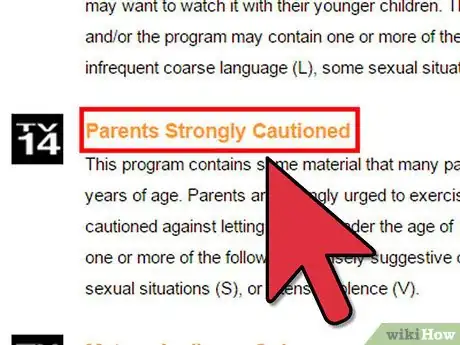X
wikiHow is a “wiki,” similar to Wikipedia, which means that many of our articles are co-written by multiple authors. To create this article, 14 people, some anonymous, worked to edit and improve it over time.
This article has been viewed 16,870 times.
Learn more...
Children are only young for a short time. TV programs with adult material makes them grow up too fast. If you want to know about TV ratings, see below.
Steps
-
1Know that TV-Y means Children. Programs rated TV-Y are designed to be appropriate for all children. The thematic elements portrayed in programs with this rating are specifically designed for a very young audience, including young children ages 6 and under. According to the FCC, programs are "not expected to frighten younger children".
-
2Know that TV-Y7 means Directed to older children. Programs rated TV-Y7 are designed for children age 7 and older. The FCC implies that it "may be more appropriate for children who have acquired the developmental skills needed to distinguish between make-believe and reality." The thematic elements portrayed in programs with this rating may include 'comedic violence', or may be frightening or confusing for children under the age of 7.
- Fantasy Violence (FV): The violence could be fantasy. The fantasy violence is only found at the TV-Y7 program.
- TV-Y7 can also contain rude words such as "stupid" or "idiot". TV-Y7 and above can contain those two words while TV-Y does not because it is rude and inappropriate for a young child.
Advertisement -
3Know that TV-G means General Audiences. Programs rated TV-G are generally suitable for all ages. The FCC states that "this rating does not signify a program designed specifically for children, most parents may let younger children watch this program unattended." The thematic elements portrayed in programs with this rating contain little or no violence, no strong language, and little or no sexual dialogue or situations
- TV-G programs can contain little or no violence, sexual situation or dialogue and no strong language.
-
4Know that TV-PG means Parental Guidance Suggested. Programs rated TV-PG contain material that parents and guardians may find inappropriate for young children under the age of 10.
- Sexual Dialogue (D): There can be some sexual dialogue.
- Language (L): Can contain mild profanity..
- Sexual Situations/Content (S): Can contain some sexual situations and nudity must be brief.
- Violence (V): Can be mild but not high.
-
5Know that TV-14 means Parents Strongly Cautioned. Programs rated TV-14 may contain some material that parents and guardians may find unsuitable for children under the age of 14. The FCC warns that "Parents are cautioned to exercise some care in monitoring this program and are cautioned against letting children under the age of 14 watch unattended."
- Sexual Dialogue (D): There can be strong sexual dialogue.
- Language (L): TV-14 shows can contain stronger language. Any words that are too strong will be censored by a bleep.
- Sexual situations/content (S): Can contain less brief nudity and if nudity isn't brief, it will be censored or invisible.
- Violence (V): Can be strong or intense at a mild level.
-
6Know that TV-MA means Mature Audiences Only. Programs rated TV-MA are usually designed to be viewed by adults. Some content may be unsuitable for children under the age of 17.
- Language (L): Can be strong language depending on the program your watching, the strong language will either be censored or uncut. Some words can also be very offensive to someone's race or religion
- Sexual Situations/Content (S): Can either be censored or Uncut. In uncut you can see certain body parts.
- Violence (V): Can be Graphic violence or intense at a high level. There can also be blood and gore.
Advertisement
About This Article
Advertisement































































